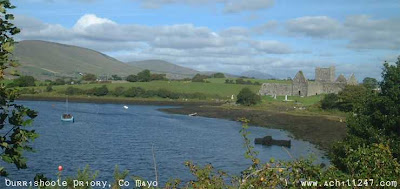
After yesterday's post and talk of Ireland, I thought it was time for my second installment of Churches of my forefathers.
Burrishoole Abbey
From the sign at the Abbey/Friary:
Dominican friars first came to Ireland in 1224. By the time of the suppression of the monasteries by Henry VIII in 1540, they had established 38 houses. This Dominican Friary, dedicated to St. Mary, was founded around 1470 by Richard de Burgo of Turlough, Lord MacWilliam Oughter. Permission of the Pope had not been sought for its foundation -- an oversight for which the community faced a threat of excommunication -- but in 1486, the Pope instructed the Archbishop of Tuam to forgive the friars.
All that remains today is the church and the eastern wall of the cloister in thich the monks walked and meditated. All the domestic buildings -- the kitchens, the dormitories and the refectory -- have been detroyed. The church consists of a nave and chancel, a south transcept and a low tower. A 15th century bronze seal, which may have been the official seal of the friary, was found embedded in a window of the upstairs dormitory.

The site is very serene and well-kept, located on an inlet of the sea. The area features prominently in the legendary "Year of the French," of which a book and movie were made. The Year of the French was a period in the late 1700s, when the local Irish rebelled against their English oppressors, with the assistance of the French. Needless to say, things didn't go very well and the French abandoned their attempts and left the poor Irish rebels to deal with the consequences. In the middle of Burrishoole Abbey is a large Celtic cross headstone for a priest, Father Manus Sweeney, who was hung for his involvement in the uprising (shown below).


Here's a poem by Pete St. John:
On an angry autumn morning, sailing down Killala bay
Came the Frenchmen and their general, too late to save the day
And my Nora waved them welcome, while I still nursed my wounds
Cruel marks from Tubberneering and all my dreams in ruins
Ah, you Frenchman, ah, you Frenchman! You've come too late again
To save the flower of freedom that's crushed in every glen
And your fancy General Humbert, well intended tho' he be
Will never reap the harvest that was promised to the free
At Castlebar he chased them, like foxes 'fore the hounds
Lord Roden's vaunted cavalry they raced across the ground
Seven hundred fiery Frenchmen, Mayo rebels, two cannon-gun
But I thought of Father Murphy lying dead with Wexford's sons
Then early in September, I saw it all again
Cornwallis and his thousands drove Humbert down the glen
While the beaten French were sent to France, the rebels they were slain
With Tone and Teeling martyred, the banshee cried again






















3 comments:
Lovely post! My ancestors on my mother's side also come from Ireland. Just think of all the generations of my kin who were Irish and not American - how quickly things change...how sad it is to lose one's heritage
Both sides of my family have a large smattering of Irish. I know the homelands of all my mother's Irish ancestors, but none of my father's. My mother's hail from Counties Mayo, Galway and Kildare. I believe my father's are from Cork or Kerry, but with names like Lynch and Moore, it's like hunting a needle in a haystack. I love genealogy for the historical aspects. Learning about the places and the cultures of where my ancestors are from is fascinating.
On the occasion of my son's (Michael Martin Conway) First Holy Communion, April 24 2101 in Towson Maryland USA, we remember our forefathers in faith and family....particularly great uncle Patrick Chambers and his father William Chambers both buried at Burrishoole Abbey.........
Post a Comment